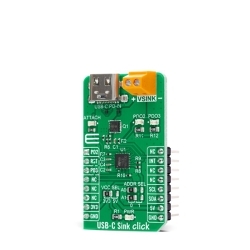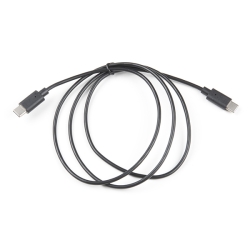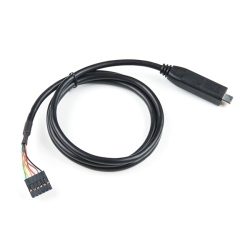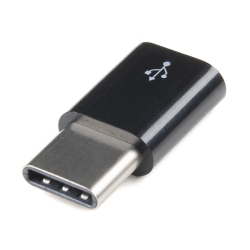MIKROE USB-C Sink Click
USB-C Sink Click is a compact add-on board that contains a standalone autonomous USB power delivery controller.
Product Overview
USB-C Sink Click is a compact add-on board that contains a standalone autonomous USB power delivery controller. This board features the STUSB4500, a USB-C sink-only controller compatible with Power-Delivery (PD) from STMicroelectronics. It supports dead battery mode to allow a system to be powered from an external source directly, establishes a valid source-to-sink connection, and negotiates a USB power delivery (PD) contract with a PD capable source device. Combined with the capability to directly negotiate a power contract, this Click board™ makes it an excellent choice for various applications like autonomous systems that requires high power charging profile to be fully operational.
USB-C Sink Click is supported by a mikroSDK compliant library, which includes functions that simplify software development.
USB-C Sink Click is based on the STUSB4500, a USB-C sink-only controller compatible with Power-Delivery (PD) from STMicroelectronics. Based on the default power profiles (PDO) configuration stored in internal non-volatile memory, the stand-alone controller STUSB4500 implements proprietary algorithms to negotiate a Power Delivery contract with a source without any internal or external software support (Auto-Run Mode), making it the ideal device for automatic High Power Profile charging, especially from a Dead Battery Power state.
This Click board™ has the VBUS monitoring block that supervises from the VBUS_VS_DISCH input pin the VBUS voltage on the USB Type-C receptacle side. It is used to check that VBUS is within a valid voltage range to establish a correct Source-to-Sink connection and to enable a safe VBUS power path through the VBUS_EN_SNK pin. It allows the detection of unexpected VBUS voltage conditions such as undervoltage or overvoltage relative to the valid VBUS voltage range. The STUSB4500 also has a pin that is asserted when a valid Source-to-Sink connection is established, and when a connection to a debug accessory device is detected which is presented visually with a Blue LED diode labeled as ATTACH.
The STUSB4500 communicates with MCU using the standard I2C interface that supports transfers up to 400 Kbit/s (Fast Mode) used to configure, control, and read the status of the device. It also has the possibility of the USB Power Delivery communication over CC1 and CC2 configuration channel pins used for connection and attachment detection, plug orientation determination, and system configuration management across USB Type-C cable. Four 7-bit device address is available by default (0x28 or 0x29 or 0x2A or 0x2B) depending on the setting of the address pin ADDR0 and ADDR1. These pins are programmed by the user, determines the LSBs of the peripheral address, and it can be selected by positioning the onboard SMD jumpers labeled as ADDR SEL.
Additional functionality, such as Reset and ‘Alert’ interrupt is provided and routed at RST and INT pins of the mikroBUS™ socket. The RST pin resets all analog signals, states machine, and reloads configuration, while an interrupt output labeled as INT represents alarm output. Also, there are 2 additional green diodes associated with two pins on the mikroBUS™ socket (labeled as PO2 and PO3) that report by default the status of the USB power delivery contract negotiation with the source labeled as PDO2 and PDO3.
This Click board™ is designed to be operated with both 3.3V and 5V logic voltage levels that can be selected via VCC SEL jumper. This allows for both 3.3V and 5V capable MCUs to use the I2C communication lines properly.
Features & Specs
- Interface: I2C
- Compatibility: mikroBUS™
- Dimensions: 42.9 x 25.4mm
- Input Voltage: 3.3V or 5V
- Supply Voltage: Min. 5V, Max. 20V
- Supply Voltage on CC pins: Min. -0.3V, Max. 5.5V
- Operating Supply Current: 160μA
- Operating Temperature Range: Min. -40°C, Max. +105°C
Documentation
Customer Reviews

Stock and Customer Discounts
Available Discounts
- $11.35 | 25+ units
- $10.76 | 100+ units









